#Geographical heritage
Explore tagged Tumblr posts
Text
My mom's geographical heritage is too confusing and it hurts my brain to think about it.
#Like#She says she's Russian#But was born in kasachstan#And then told me that my grandma is technically Ukrainian#Or at least half Ukrainian#i hate it#My poor head#my head huuuurts#:3#help#lol#witness for the prosecution#my head is going to explode#my head feels like its gonna explode#Geographical heritage
1 note
·
View note
Text

Geographically tagged dolls aren't just toys, they're cultural ambassadors!
https://youtu.be/5KQwZJnXqLU
#Geographical Indication#Dolls#WorlddollDay#handmade#toys#handicrafts#empowercreator#artisans#channapatna#manipur#Thanjavur#culture#heritage
0 notes
Text
What does life in North Korea look like outside of Pyongyang? 🇰🇵
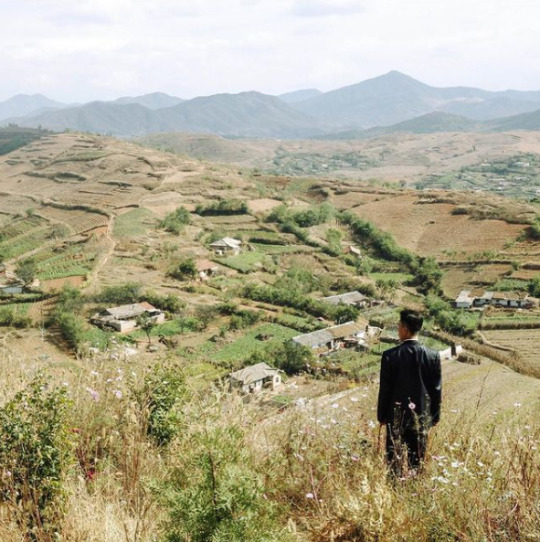
Hey, I'm back again with a very scary "tankie" post that asks you to think of North Koreans as people, and to consider their country not as a cartoonish dystopia, but as a nation that, like any other place on earth, has culture, traditions, and history.
Below is a collection of pictures from various cities and places in North Korea, along with a brief dive into some of the historical events that informs life in the so-called "hermit kingdom."
Warning: very long post
Kaesong, the historic city
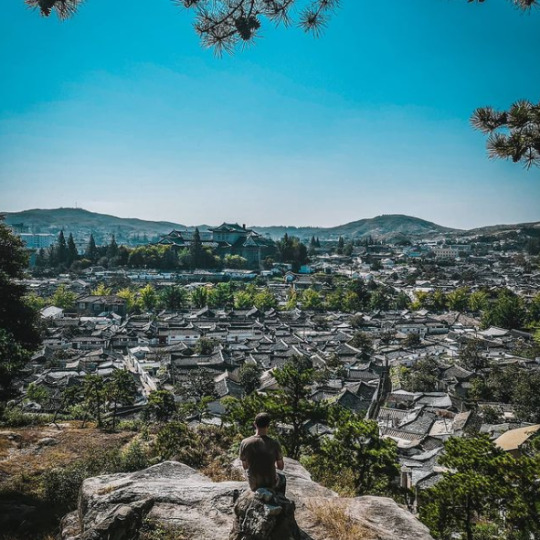
Beginning this post with Kaesong, one of the oldest cities in Korea. It's also one of the few major cities in the DPRK (i.e. "North Korea") that was not completely destroyed during the Korean war.
Every single city you'll see from this point on were victims of intense aerial bombardments from the U.S. and its allies, and had to be either partially or completely rebuilt after the war.
From 1951 to 1953, during what has now become known as the "forgotten war" in the West, the U.S. dropped 635,000 tons of bombs over Korea — most of it in the North, and on civilian population centers. An additional 32,000 tons of napalm was also deployed, engulfing whole cities in fire and inflicting people with horrific burns:
For such a simple thing to make, napalm had horrific human consequences. A bit of liquid fire, a sort of jellied gasoline, napalm clung to human skin on contact and melted off the flesh. Witnesses to napalm's impact described eyelids so burned they could not be shut and flesh that looked like "swollen, raw meat." - PBS
Ever wondered why North Koreans seem to hate the U.S so much? Well...
Keep in mind that only a few years prior to this, the U.S. had, as the first and only country in the world, used the atomic bomb as a weapon of war. Consider, too, the proximity between Japan and Korea — both geographically and as an "Other" in the Western imagination.
As the war dragged on, and it became clear the U.S. and its allies would not "win" in any conventional sense, the fear that the U.S. would resort to nuclear weapons again loomed large, adding another frightening dimension to the war that can probably go a long way in explaining the DPRK's later obsession with acquiring their own nuclear bomb.
But even without the use of nuclear weapons, the indiscriminate attack on civilians, particularly from U.S. saturation bombings, was still horrific:
"The number of Korean dead, injured or missing by war’s end approached three million, ten percent of the overall population. The majority of those killed were in the North, which had half of the population of the South; although the DPRK does not have official figures, possibly twelve to fifteen percent of the population was killed in the war, a figure close to or surpassing the proportion of Soviet citizens killed in World War II" - Charles K. Armstrong
On top of the loss of life, there's also the material damage. By the end of the war, the U.S. Air Force had, by its own estimations, destroyed somewhere around 85% of all buildings in the DPRK, leaving most cities in complete ruin. There are even stories of U.S. bombers dropping their loads into the ocean because they couldn't find any visible targets to bomb.
What you'll see below of Kaesong, then, provides both a rare glimpse of what life in North Korea looked like before the war, and a reminder of what was destroyed.
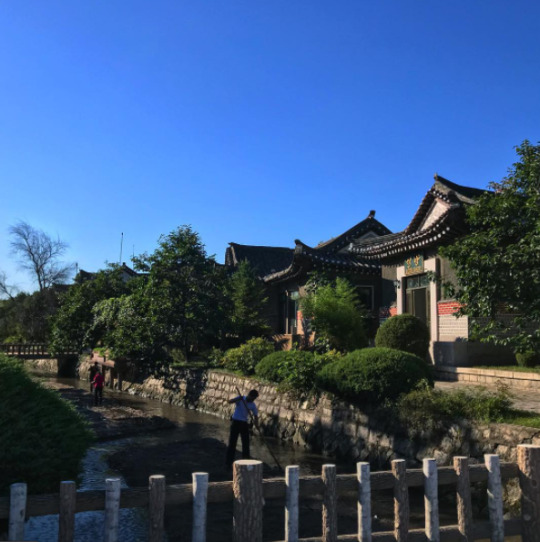
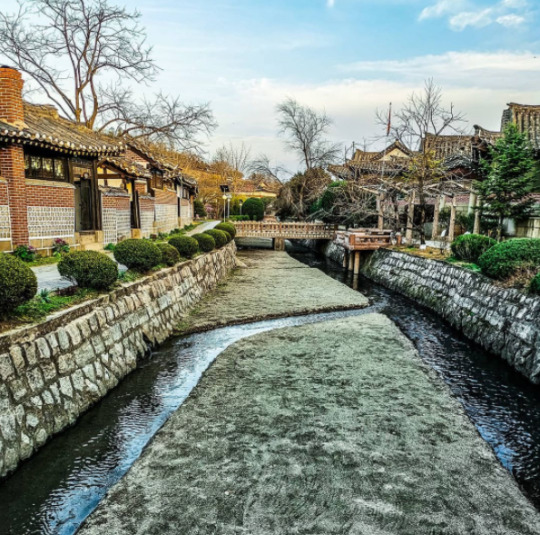
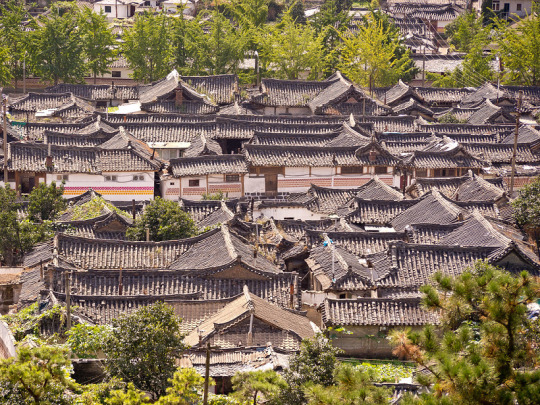
Kaesong's main street, pictured below.
Due the stifling sanctions imposed on the DPRK—which has, in various forms and intensities, been in effect since the 1950s—car ownership is still low throughout the country, with most people getting around either by walking or biking, or by bus or train for longer distances.
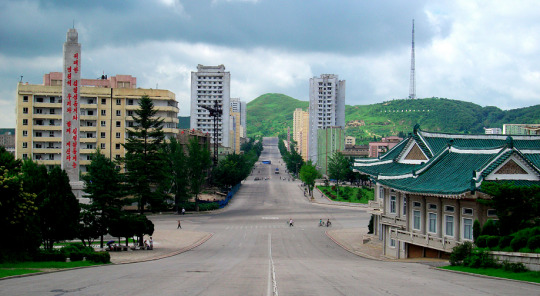
Kaesong, which is regarded as an educational center, is also notable for its many Koryŏ-era monuments. A group of twelve such sites were granted UNESCO world heritage status in 2013.
Included is the Hyonjongnung Royal Tomb, a 14th-century mausoleum located just outside the city of Kaesong.
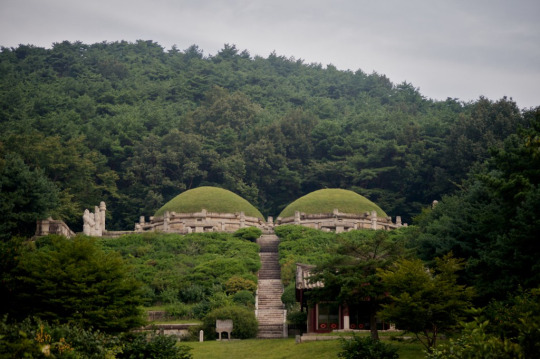
One of the statues guarding the tomb.

Before moving on the other cities, I also wanted to showcase one more of the DPRK's historical sites: Pohyonsa, a thousand-year-old Buddhist temple complex located in the Myohyang Mountains.
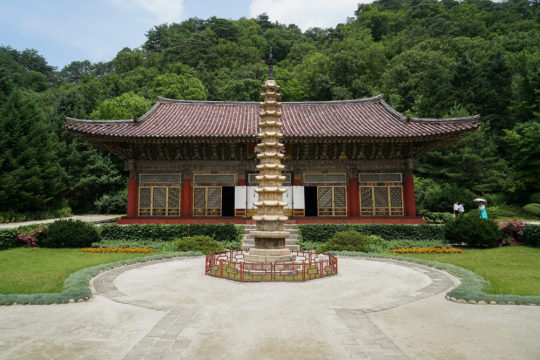
Like many of DPRK's historic sites, the temple complex suffered extensive damage during the Korean war, with the U.S. led bombings destroying over half of its 24 pre-war buildings.
The complex has since been restored and is in use today both as a residence for Buddhist monks, and as a historic site open to visitors.


Hamhung, the second largest city in the DPRK.
A coastal city located in the South Hamgyŏng Province. It has long served as a major industrial hub in the DPRK, and has one of the largest and busiest ports in the country.
Hamhung, like most of the coastal cities in the DPRK, was hit particularly hard during the war. Through relentless aerial bombardments, the US and its allies destroyed somewhere around 80-90% percent of all buildings, roads, and other infrastructure in the city.
Now, more than seventy years later, unexploded bombs, mortars and pieces of live ammunition are still being unearthed by the thousands in the area. As recently as 2016, one of North Korea's bomb squads—there's one in every province, faced with the same cleanup task—retrieved 370 unexploded mortar rounds... from an elementary school playground.
Experts in the DPRK estimate it will probably take over a hundred years to clean up all the unexploded ordnance—and that's just in and around Hamhung.
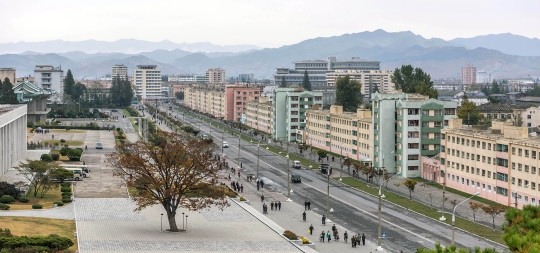
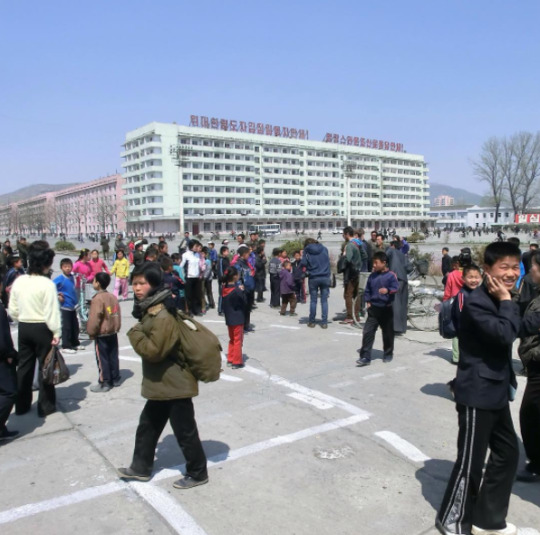
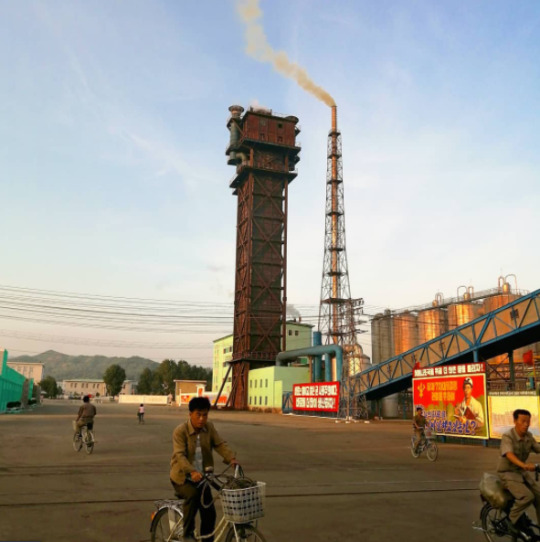
Hamhung's fertilizer plant, the biggest in North Korea.
When the war broke out, Hamhung was home to the largest nitrogen fertilizer plant in Asia. Since its product could be used in the creation of explosives, the existence of the plant is considered to have made Hamhung a target for U.S. aggression (though it's worth repeating that the U.S. carried out saturation bombings of most population centers in the country, irrespective of any so-called 'military value').
The plant was immediately rebuilt after the war, and—beyond its practical use—serves now as a monument of resistance to U.S. imperialism, and as a functional and symbolic site of self-reliance.
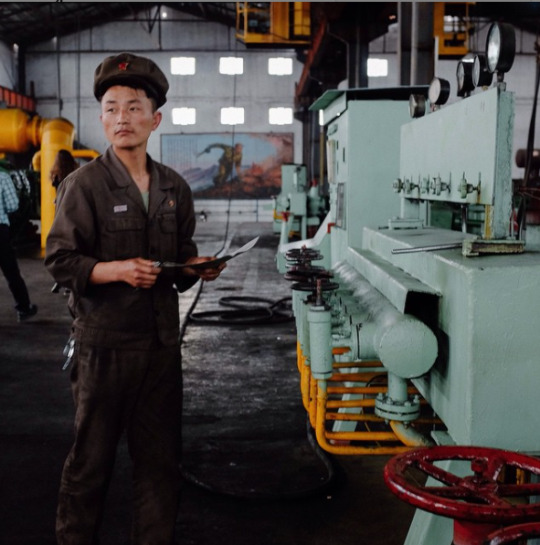
Chongjin, the third largest city in the DPRK.
Another coastal city and industrial hub. It underwent a massive development prior to the Korean war, housing around 300,000 people by the time the war broke out.
By 1953, the U.S. had destroyed most of Chongjin's industry, bombed its harbors, and killed one third of the population.
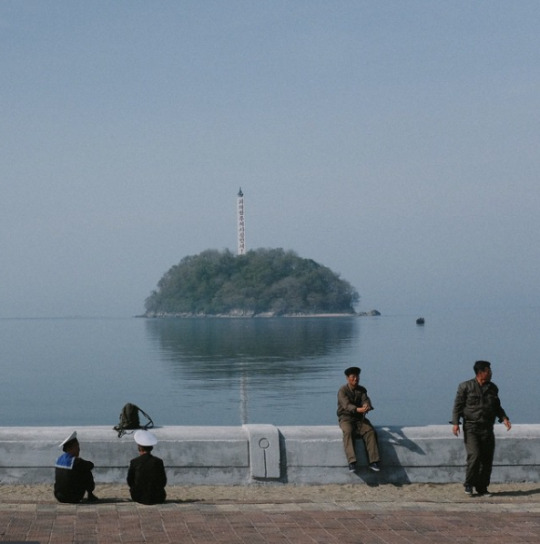


Wonsan, a rebuilt seaside city.
The city of Wonsan is a vital link between the DPRK's east and west coasts, and acts today as both a popular holiday destination for North Koreans, and as a central location for the country's growing tourism industry.
Considered a strategically important location during the war, Wonsan is notable for having endured one of the longest naval blockades in modern history, lasting a total of 861 days.
By the end of the war, the U.S. estimated that they had destroyed around 80% of the city.
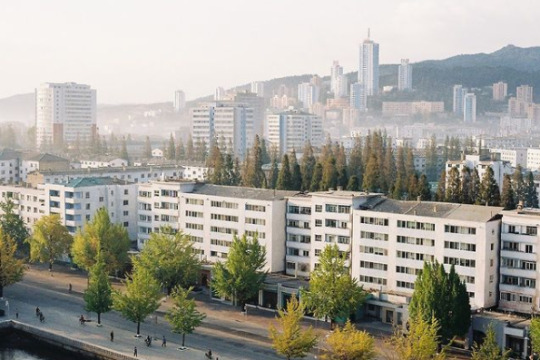
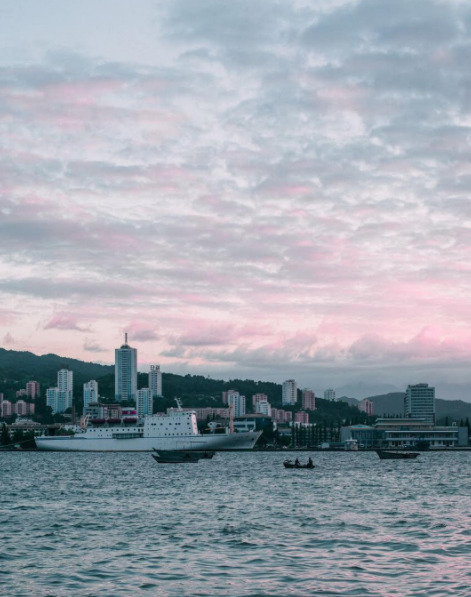
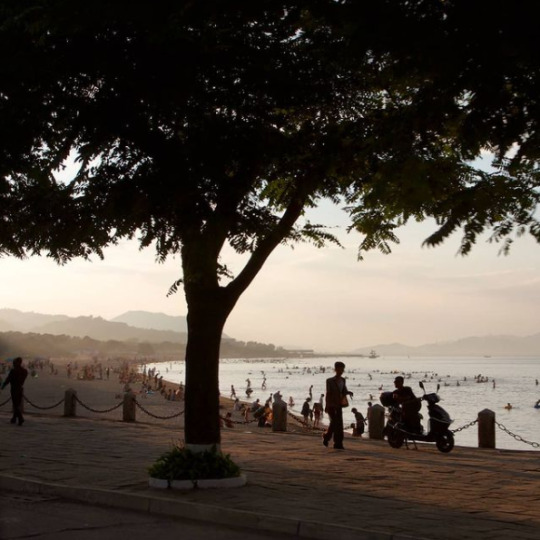
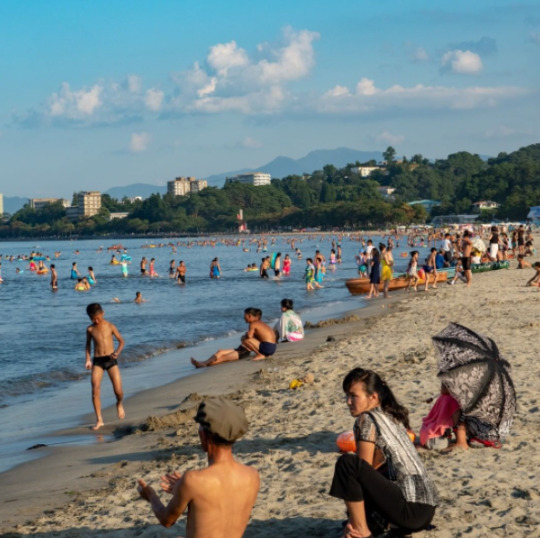
Masikryong Ski Resort, located close to Wonsan. It opened to the public in 2014 and is the first, I believe, that was built with foreign tourists in mind.
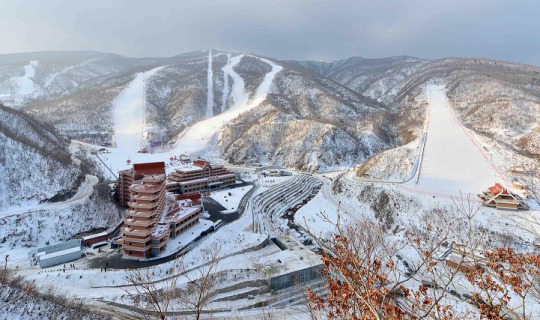
Sariwon, another rebuilt city
One of the worst hit cities during the Korean War, with an estimated destruction level of 95%.
I've written about its Wikipedia page here before, which used to mockingly describe its 'folk customs street'—a project built to preserve old Korean traditions and customs—as an "inaccurate romanticized recreation of an ancient Korean street."
No mention, of course, of the destruction caused by the US-led aerial bombings, or any historical context at all that could possibly even hint at why the preservation of old traditions might be particularly important for the city.
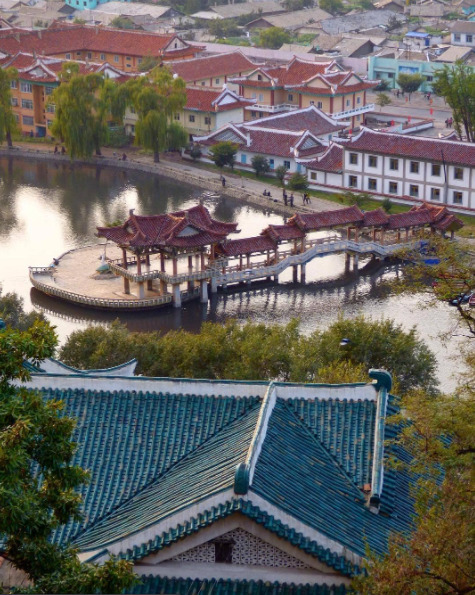

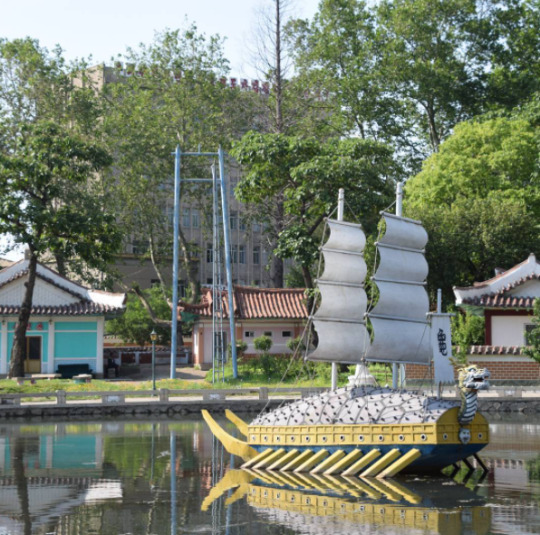
Life outside of the towns and cities
In the rural parts of the DPRK, life primarily revolves around agriculture. As the sanctions they're under make it difficult to acquire fuel, farming in the DPRK relies heavily on manual labour, which again, to avoid food shortages, requires that a large portion of the labour force resides in the countryside.
Unlike what many may think, the reliance on manual labour in farming is a relatively "new" development. Up until the crisis of the 1990s, the DPRK was a highly industrialized nation, with a modernized agricultural system and a high urbanization rate. But, as the access to cheap fuel from the USSR and China disappeared, and the sanctions placed upon them by Western nations heavily restricted their ability to import fuel from other sources, having a fuel-dependent agricultural industry became a recipe for disaster, and required an immediate and brutal restructuring.
For a more detailed breakdown of what lead to the crisis in the 90s, and how it reshaped the DPRKs approach to agriculture, check out this article by Zhun Xu.

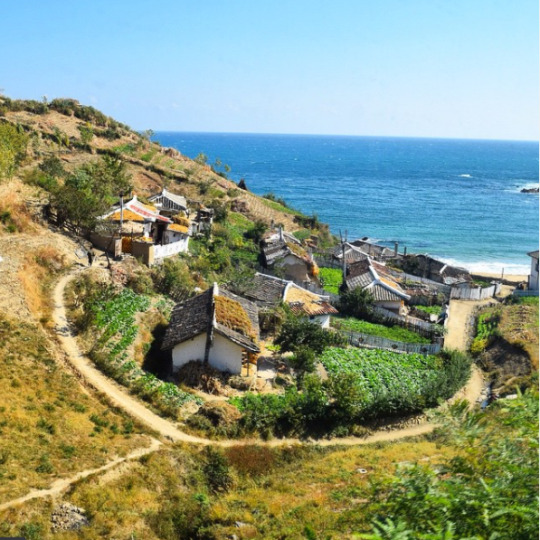
Some typical newly built rural housing, surrounded by farmland.
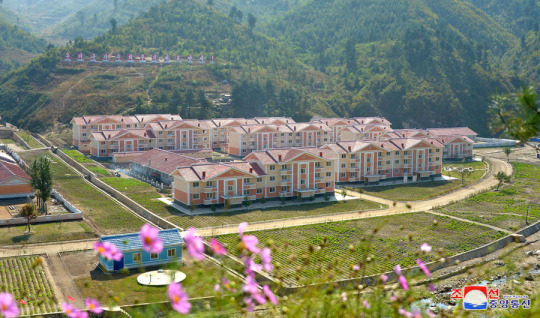
Tumblr only allows 20 pictures per post, but if you want to see more pictures of life outside Pyongyang, check out this imgur album.
#dprk#north korea#i've had this post unfinished in drafts for almost a year#also sorry about the spelling and potential formatting issues it's a nightmare to edit at this point#it was literally just meant to be a collection of picture and then the writing just sort of happened#enjoy the brief heritageposts history lesson i guess
6K notes
·
View notes
Text
মেচা সন্দেশের অগ্নিপরীক্ষা! কী রয়েছে এই বিখ্যাত মিষ্টির ভাগ্যে, অপেক্ষায় সকলে
নীলাঞ্জন বন্দ্যোপাধ্যায়, বাঁকুড়া: বেলিয়াতোড়ের বিখ্যাত মেচা সন্দেশের অগ্নিপরীক্ষা! কী রয়েছে মেচা সন্দেশের ভাগ্যে? ছাত্র জীবনে আমরা কম বেশি প্রত্যেকেই পরীক্ষা দিয়ে থাকি। তবে বাঁকুড়ার এই বিখ্যাত মিষ্টিকেও দিতে হচ্ছে পরীক্ষা। তবে কি অবশেষে পেতে চলেছে জি আই অর্থাৎ জিওগ্রাফিকাল আইডেন্টিফিকেশন এর তকমা? বাঁকুড়ার বেলিয়াতোড়ে আপাতত খুশির হাওয়া লাগলেও এখনো একটি “যদি” গলায় আটকে আছে। যেমনভাবে…

View On WordPress
#bankura news#Geographical identification tag#heritage food#local food#mecha sandesh of Bankura#বাঁকুড়ার বিখ্যাত সন্দেশ#বাঁকুড়ার মেচা সন্দেশ#মেচা সন্দেশের জন্য জিআই ট্যাগ
0 notes
Text
(2nd meeting) 2023/3rd Session of the United Nations Group of Experts on Geographical Names.
This session will address the theme "Strengthening relationships, links and connections in geographical names standardization and for sustainable development and pandemic recovery". This theme is not only aligned to the theme of the 2023 ECOSOC High-level Political Forum on sustainable development, but also to UNGEGN's Strategic Plan and Programme of Work 2021-2029, Strategy 2: Relationships, links and connections.
#toponymy#UNGEGN#Plenary meetings#sustainable development#geographical indication#standardization#covid 19 recovery#creative industry#cultural heritage
0 notes
Text
I think that American Evangelicals often find it challenging to understand and empathise with Christians in the Middle East due to the stark contrasts between their cultural contexts and theological foundations, which are closely intertwined. Evangelicalism places a strong emphasis on individualism, particularly a personal relationship with Jesus, focusing heavily on privatised salvation and direct access to God through prayer and scripture. This privatisation of religious life contrasts sharply with the communal and sacramental expressions of Christianity prevalent in the Middle East. There, faith is practised within a collective framework that emphasises communal worship, shared rituals, and long-standing traditions that have transcended centuries. For many Christians in the Middle East, the Church is not merely a place for personal worship but an important institution that preserves traditions, cultural heritage, and social cohesion, especially in regions where Christians, as a minority, face persecution or marginalisation.
The sacraments, which are largely absent from Evangelical practice, play a central role in fostering communalism and spiritual life for Middle Eastern Christians. The sacraments are not merely symbolic acts of individual faith but deeply communal experiences that bind believers together. Among them, the Eucharist holds a place of profound significance, serving as the central act of worship in many Christian traditions. The Eucharist is not simply a memorial of Christ's sacrifice; it is a shared ritual that embodies the unity of the Church, transcending time and space, and connecting believers with fellow Christians across the world and throughout history. This communal aspect of Christian life, particularly evident in Middle Eastern Christian communities, reflects the vision Christ had for His Church— a community of believers bound by love, shared faith, and common worship. These communities are not just descendants of the first Christians in a geographical sense; they are the living embodiment of the traditions and practices that have defined the Church from its earliest days.
576 notes
·
View notes
Text
2,000-Year-Old Fayum Portraits from Roman Egypt: also known as "mummy portraits," these funerary paintings were often fastened to the coffins of the people they depicted
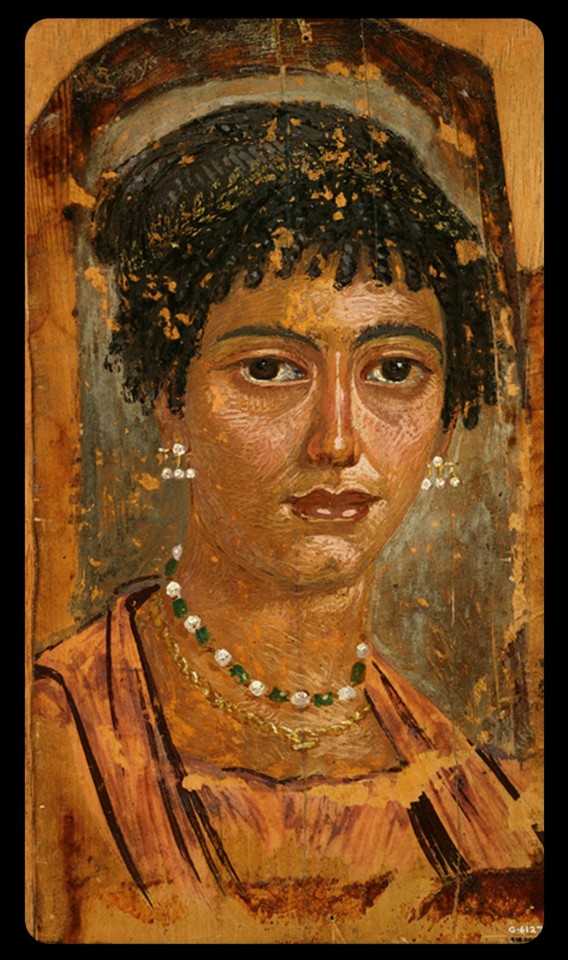
Above: Fayum portrait of a woman from Roman-occupied Egypt, c.100-110 CE
Fayum portraiture was a popular funerary practice among the upper-class families of Roman Egypt from about 50 CE to 250 CE. Given the high mortality rates for children during this period, many of these portraits depict children and youths, but adults were often featured, too.
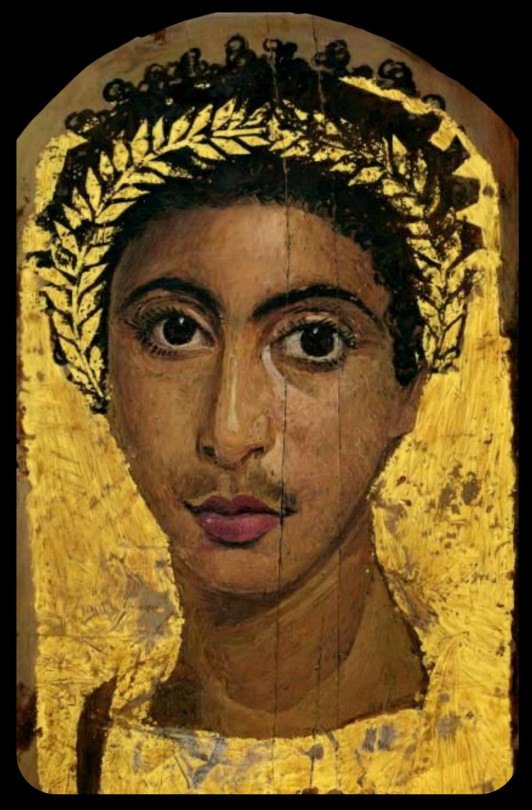
Above: portrait of a youth wearing a golden wreath, c.130-150 CE; the wreath and the background of the portrait are both gilded
The population of the Faiyum Delta, where most of these portraits were found, largely contained individuals with both native Egyptian/North African and Greek heritage. The Greek lineages can be traced back to the Ptolemaic period, when the Greeks gained control of Egypt and began to establish settlements throughout the region, gradually leading to a cultural diffusion between the Greek and Egyptian populations. The Romans eventually took control of Egypt in 31 CE, absorbing it into the Roman Empire and colonizing much of North Africa, but the demographics of the Faiyum Delta remained largely unchanged.
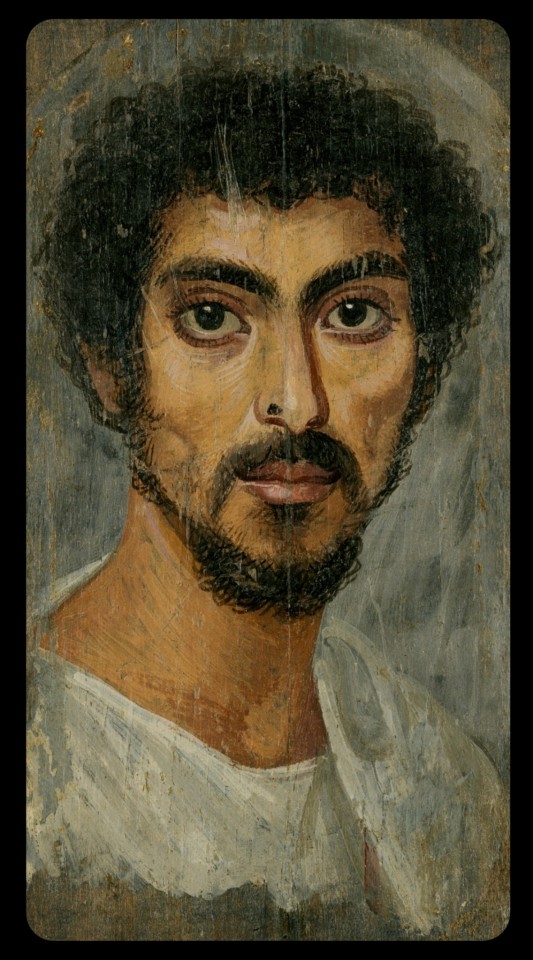
Above: portrait of a man with a mole on his nose, c.130-150 CE
Many of these Fayum portraits reflect the same blend of ethnic and cultural roots, depicting individuals with both Greek and native Egyptian heritage (a claim that is supported by both archaeological and genetic evidence). Some portraits may also depict native Egyptians who did not have any European ancestry, but had been integrated into Greco-Roman society.
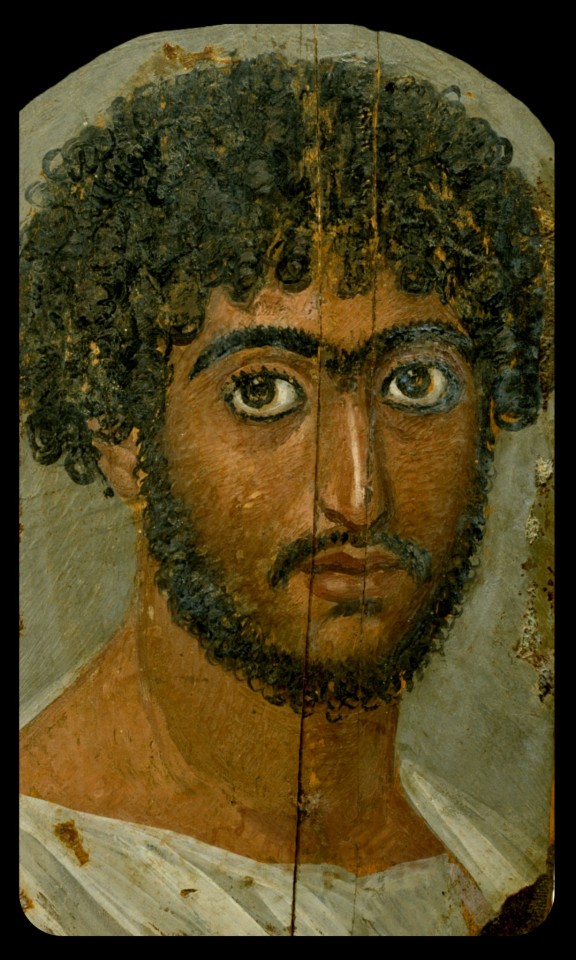
Above: portrait of a bearded man, c.170-180 CE
These representations of native Egyptians provide us with unique insights into the actual demographics of Roman-occupied Egypt (and the ancient world at large). Non-European peoples are rarely included in depictions of the classical world; it's also interesting to see the blend of cultural elements that these portraits represent.

Above: portrait of a priest of Serapis, c.140-160 CE; the man in this portrait is shown wearing a fillet/crown that bears the seven-pointed star of the Greco-Egyptian god, Serapis
As this article explains:
In the 1800s and early 1900s, Western art historians didn’t know what to make of these portraits. Scholars of Roman history labeled them Egyptian. Scholars of Egyptian history labeled them Greco-Roman. These binary academic classifications failed to capture the true complexity of the ancient (or, indeed, modern) Mediterranean. In reality, Fayum portraits are a syncretic form, merging Egyptian and Greco-Roman art and funerary practices. They reflect the cosmopolitanism of both Roman and Egyptian history.
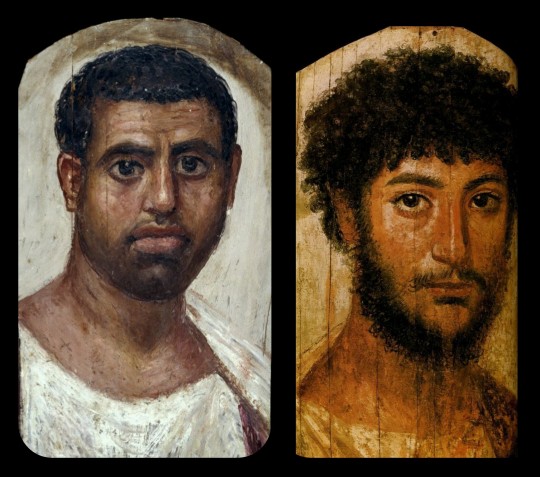
Above: portrait of a man, c.80-100 CE (left); portrait of a bearded officer, sometimes referred to as "Perseus," c.130-175 CE (right)
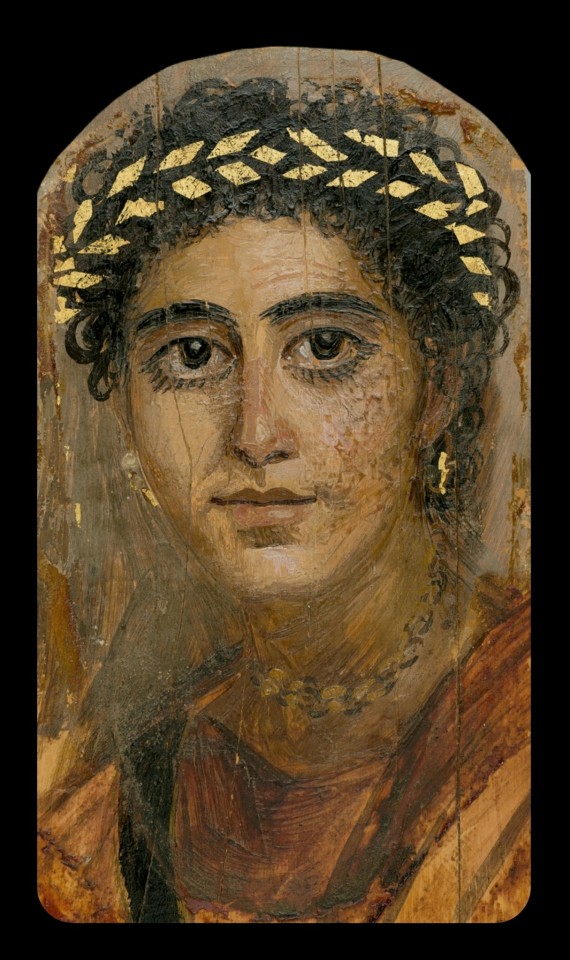
Above: portrait of a young woman in red, c.90-120 CE
Nearly 1,000 of these portraits are currently known to exist.
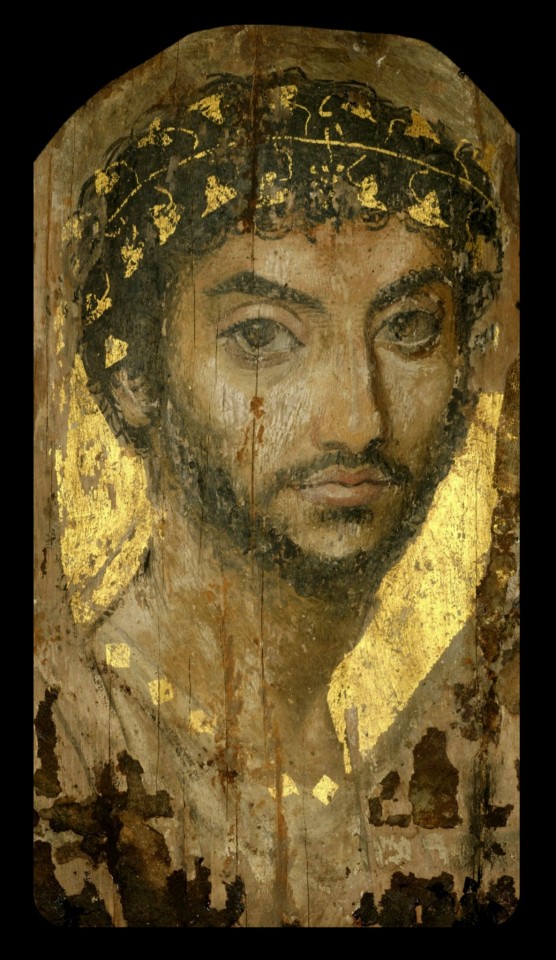
Above: portrait of a man wearing a gilded ivy wreath, c.100-150 CE
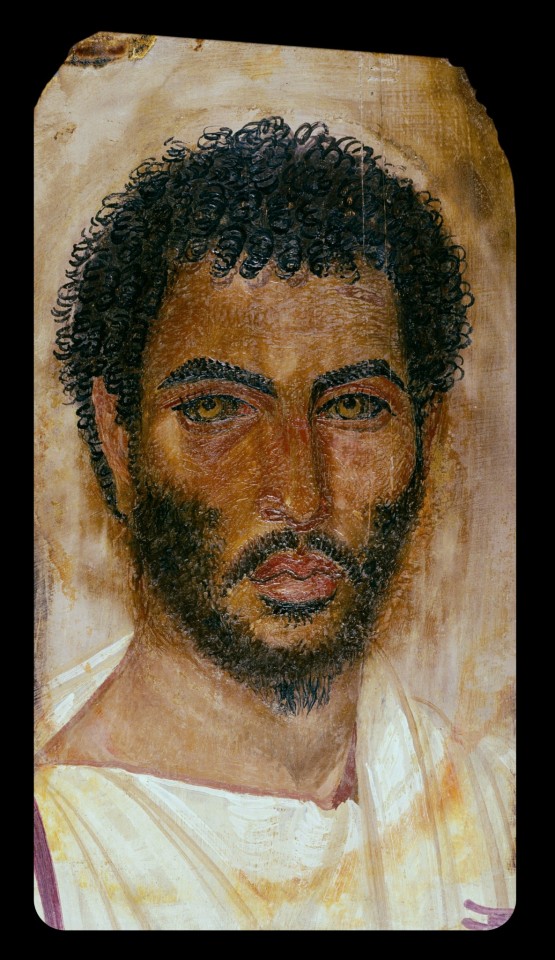
Above: portrait of a bearded man, c.150-170 CE
Sources & More Info:
Curationist: Fayum Portraits
Harvard Art Museums: Giving the Dead their Due: an Exhibition Re-Examines Funerary Portraits from Roman Egypt
Getty Museum: APPEAR Project
Getty Museum: Faces of Roman Egypt
National Geographic: Ancient Egypt's Stunning, Lifelike Mummy Portraits
The Athens Centre: The Myth of Whiteness in Classical Sculpture
Forbes: Whitewashing Ancient Statues: Whiteness, Racism and Color in the Ancient World
#archaeology#artifact#anthropology#history#ancient history#art#fayum portraits#roman egypt#ancient rome#ethnography#painting#portrait#north africa#people of color#egypt#religion#greco roman#greek#classical antiquity#fayum#mummy portraits#romano egyptian#representation
363 notes
·
View notes
Text
Genuinely kind of bothers me how like all fantasy media always has a 'common language' and the only unique languages are just like. Languages unique to one species that All members of that species speak like all dwarves speak 'dwarvish'. No, let them all have a ridiculous amount of languages. And it doesn't make sense to base speech entirely off of heritage or species. The way it sounds might be different due to the difference in vocal chords but most languages would be specific to geographic areas, not entire species. Yes there are obviously going to be cases where only one species lives in an area and so that language is only spoken by that species but most of the time I'd expect that there's going to be multiple groups of people from multiple species living in the same place. And if there is a 'common language' then its likely to be one acting more like latin in medieval europe than a universal language. It's a language spoken by scholars mostly and if you try talking to a random village farmer then they're not going to get anything from it.
468 notes
·
View notes
Text
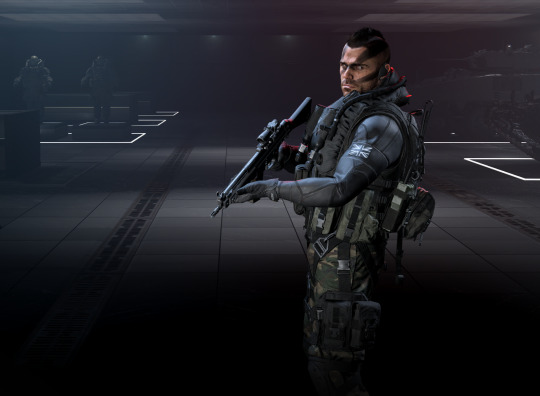
Ghost: *hands Johnny a tea* Here, this’ll sort ya out. Soap: I swear you fuckin’ Brits think tea’ll fix anything. Rudy: *confused* You’re both British, no? Alejandro: *kicks Rudy under the table* *Whispers* Now you’ve done it… Soap: *sipping tea* I identify as Scottish. Ghost: You can identify as a fuckin’ tree, mate. But it don’t change nothin’ Scotland’s part of Britain…you’re British. Soap: Geographically, aye. But that’s no’ the point! Ghost: You know, none of the Welsh or Irish boys make as much noise about it as you… Soap: This doesny concern them! Rudy: *to Gaz* Are they going to fight… Did I miss something? Gaz: *who’s been sitting quiet* Nah mate, this is foreplay for them…I’m just glad my room’s not next to theirs…
Some Soap Headcanons/Thoughts from a Scottish person? 👇🏼
“Fuckin’ Brits!”
I’ve seen a lot of folks mention how odd it was, and that the writers have somehow forgotten about Scotland being a part of Britain.
Some folks have suggested that maybe this was just an attempt of them writing Soap as a Nationalist only to be countered with comments that he would have said “Fuckin’ English.” Because Scotland is still a part of Great Britain.
Keep in mind that “British” is often used as a generalisation by many for those living in the UK, so anyone who is strongly against the Union may refuse to associate themselves with it and strongly emphasise by affirming their “I’m Scottish.”
Whatever Soap’s political views on the treaty of Union, signed all the way back on the 1st May 1707, matter not, because it’s purely banter. The Scots and English have history, and they’re playing with it (Especially when you consider Ghost's whole “Speak English.” stuff.)
As a Scottish person, who’s man was also born here, but his family are English, I often take the piss about his heritage…some of us are just like that, okay? 🤣
Soap’s accent.
I’ve seen it come up again and again in comments that Soap’s accent changes, and sometimes his Scottish accent seems forced…that his VA is clearly not a native, unlike Captain MacTavish’s…
Besides the fact that his VA is actually Scottish, Soap travels the world, he works closely with folks from all over, so it is no surprise to me that his accent is going to dip and change from time to time.
And the times where he’s “forcing it'' in"Alone ","Awa and Bile yer heid!” “It’s pishin’ it doon oot here.” c’mon now, he’s purposely trying to goad Ghost! 🤣
I worked in tourism, my colleagues came from all over. I’ve grown up with American TV shows and video games. And you bet I hear an accent and have to mimic it! When folk ask me where I’m from, it’s like a default to emphasise my accent as much as possible… oh and angry and drunk… tends to rev up the accent a little more too 👀
Basically, the accent is Scottish… with extra seasoning 🤣
#john soap mactavish#ghostsoap#ghost mw2#modern warfare#cod ghost#call of duty mwii#kyle gaz garrick#ghost riley#cod modern warfare#mw2#mw2 alejandro#mw2 rudy
455 notes
·
View notes
Text
Screen Froze
Podcasting had become inescapable in recent years. Everyone seemed to have an opinion on...well everything. Politics, world sports, cooking, an obscure movie from 1978 only released in a now-extinct language. If it could be covered, it would be. And one could find this content anywhere across the internet. Youtube, social media, even streaming services promoted their podcasters. Everyone was watching everyone talking.
Of course, with so many different podcasters flying about, it was difficult to actually spot out talent. And from a sociologically micro perspective, it was even harder for individuals to find podcasters discussing the content they actually wanted to hear about. The more unique the niche, the less people one could happen upon to be talking about it during their recorded stream of consciousness. It was a simple formula, but it forced individuals to browse for hours or even days to find what they were searching for.
Sometimes though, people could not hold such patience. They would not wait for their new hero, a disciple preaching their values and morals to audiences around the globe. They would skip past one livestream discussing the economics of green villages in Switzerland to the next debating the potential existence between a minor character in two separate fandom universes. They could even perhaps land into a podcast like Sean’s.
“Most people just don’t understand the Soviet Union’s impact on architecture,” the measly, pale nerd innocently commented. A little shy in front of the camera, he was only able to relax a bit when discussing his favorite topics. Sean dressed in theme too, wearing a brutalist-like business casual outfit, a trait his small but dedicated fanbase adored.
“There were a lot of architects that really shaped this movement from all around the world,” Sean continued. “But today, we are just going to focus on those from the USSR.”
So what happened when one’s patience dried up? Well, everything was brought to a halt.
DragonHeart49: anyone else’s screen freeze? superduperloverboy: mine too <3bitsandmore: sean, I think ur glitching out
With the screen frozen, our impatient soul could now get to work. If one could not find the podcast they were looking for, then why not just create their own? Obviously, this did not mean constructing a podcast themselves, but rather alter the fabric of reality and completely realign another’s being to their preferred state. That was much easier.
Physical modifications were made first. A much larger body was necessary, something that demanded confidence and respect from others. Juicy pecs, rippling abs, sturdy legs. There was always something unreasonably fun in bloating the podcaster’s feet up a few sizes. An imposing frame to be craved by others, even when hidden underneath clothes, was priority. And speaking of clothes, those were quickly stripped down to less formal articles. Expensive branded tee, athletic shorts so small that boxer-briefs were visible, classic white Nike socks, all of it much more respectable than a button-up and tie.
This was not the impatient soul’s first time altering a podcaster to their liking, nor would it be their last. Physically at least, each of the end products were a little different. All alpha males, but just enough variation to not warrant any unnecessary rumors. This particular podcaster had his pre-American heritage redirected from France to India, the features in the screenshot tanning accordingly as a dark stubble acquainted itself along the sharper jawline. Of course, the bulge was accurately enlarged for geographical standards too.
Mentally however, all the podcasters could be considered copies. They each spoke of the same rhetoric, theories, and ideologies that our impatient soul wanted to hear. No matter how “backwards” or “hateful” their discussions were deemed as, nearly anything could be said by hulking bodies with undeniable charisma.

“These homos have no idea what they’re talking about!” Sanjay raged as the podcast restarted, his deep voice cocky and assertive. "Sure bro, I was just thinkin’ about a girl’s rack I saw earlier today but there's more to a girl than big tits. There's a tight pussy too!”
The chat section lit off with encouragement, their fates too having been altered.
MassiveFART69: you tell them fags bro! LOL XD crassmassschlongnator: we want to BREED THEM TOO!!!! <3TITSGALORE: JUST TALKIN ABOUT IT ALREADY GOT SANJAY GRABBIN HIMSELF AGAIN
Sanjay vacantly looked down, finding himself already subconsciously scratching at the thick bush within his shorts. He let out a hot protein fart followed by a laugh, his scratching slowly extending into groping his fat 8 inch babymaker.
“God, that was WET bros!” Sanjay applauded himself, his free massive hand swallowing the mic. “Anyway, I’ll catch you on the flip side dudes, gotta go hit the gym. Bros for life!”
There was a reason the traditional masculine movement was becoming stronger. Maybe it was because men were slowly aspiring to become the alphas’ equals, or because fags were beginning to submit to their nature. Or possibly, it could have been because each time a screen froze, reality was altered one click closer to traditional, normal masculinity.
#gay to straight#male tf#male transformation#dumbification#jock tf#breeder tf#indianization#fratification
327 notes
·
View notes
Text
Once you call yourself a Negro, the scientifically written you out of existence. There is no land called Negro, no language or culture- Malcolm X

Right now, in this country, if you and I, 22 million African-Americans -- that's what we are -- Africans who are in America. You're nothing but Africans. Nothing but Africans. In fact, you'd get farther calling yourself African instead of Negro.

Black names don't exist, black land does not exist, black language does not exist. Human skin comes from the darkest brown to the lightest hues. We are Africans. African populations have the highest levels of genetic variation among all humans.- Khepri Neteru

By the early 1900s, nigger had become a pejorative word in the United States. In its stead, the term colored became the mainstream alternative to negro and its derived terms. After the American Civil Rights Movement, the terms colored and negrogave way to "black". Negro had superseded colored as the most polite word for African Americans at a time when black was considered more offensive.[126][failed verification] This term was accepted as normal, including by people classified as Negroes, until the later Civil Rights movement in the late 1960s. One well-known example is the use by Dr. Rev. Martin Luther King Jr. of "Negro" in his famous speech of 1963, I Have a Dream. During the American civil rights movement of the 1950s and 1960s, some African-American leaders in the United States, notably Malcolm X, objected to the word Negrobecause they associated it with the long history of slavery, segregation, and discrimination that treated African Americans as second-class citizens, or worse.[127] Malcolm X preferred Black to Negro, but later gradually abandoned that as well for Afro-American after leaving the Nation of Islam.[128]
Since the late 1960s, various other terms for African Americans have been more widespread in popular usage. Aside from black American, these include Afro-American (in use from the late 1960s to 1990) and African American (used in the United States to refer to Black Americans, people often referred to in the past as American Negroes).[129]
In the first 200 years that black people were in the United States, they primarily identified themselves by their specific ethnic group (closely allied to language) and not by skin color. Individuals identified themselves, for example, as Ashanti, Igbo, Bakongo, or Wolof. However, when the first captives were brought to the Americas, they were often combined with other groups from West Africa, and individual ethnic affiliations were not generally acknowledged by English colonists. In areas of the Upper South, different ethnic groups were brought together. This is significant as the captives came from a vast geographic region: the West African coastline stretching from Senegal to Angola and in some cases from the south-east coast such as Mozambique. A new African-American identity and culture was born that incorporated elements of the various ethnic groups and of European cultural heritage, resulting in fusions such as the Black church and African-American English. This new identity was based on provenance and slave status rather than membership in any one ethnic group.
By contrast, slave records from Louisiana show that the French and Spanish colonists recorded more complete identities of the West Africans, including ethnicities and given tribal names.
The U.S. racial or ethnic classification "black" refers to people with all possible kinds of skin pigmentation, from the darkest through to the very lightest skin colors, including albinos, if they are believed by others to have African ancestry (in any discernible percentage). There are also certain cultural traits associated with being "African American", a term used effectively as a synonym for "black person" within the United States

#african#afrakan#kemetic dreams#africans#brownskin#brown skin#afrakans#african culture#Malcolm x#african ancestry#igbo#ashanti#bakongo#americas#epic video#middle class negro documentary
256 notes
·
View notes
Photo

Kingdom of Abyssinia
The Kingdom of Abyssinia was founded in the 13th century CE and, transforming itself into the Ethiopian Empire via a series of military conquests, lasted until the 20th century CE. It was established by the kings of the Solomonid dynasty who, claiming descent from no less a figure than the Bible's King Solomon, would rule in an unbroken line throughout the state's long history. A Christian kingdom which spread the faith via military conquest and the establishment of churches and monasteries, its greatest threat came from the Muslim trading states of East Africa and southern Arabia and the migration of the Oromo people from the south. The combination of its rich Christian heritage, the cult of its emperors, and the geographical obstacles presented to invaders meant that the Ethiopian Empire would be one of only two African states never to be formally colonised by a European power.
Origins: Axum
The Ethiopian Highlands, with their reliable annual monsoon rainfall and fertile soil, had been successfully inhabited since the Stone Age. Agriculture and trade with Egypt, southern Arabia, and other African peoples ensured the rise of the powerful kingdom of Axum (also Aksum), which was founded in the 1st century CE. Flourishing from the 3rd to 6th century CE, and then surviving as a much smaller political entity into the 8th century CE, the Kingdom of Axum was the first sub-Saharan African state to officially adopt Christianity, c. 350 CE. Axum also created its own script, Ge'ez, which is still in use in Ethiopia today.
Across this Christian kingdom, churches were built, monasteries founded, and translations made of the Bible. The most important church was at Axum, the Church of Maryam Tsion, which, according to later Ethiopian medieval texts, housed the Ark of the Covenant. The Ark, meant to contain the original stone tablets of the Ten Commandments given by God to Moses, is supposed to be still there, but as nobody is ever allowed to see it, confirmation of its existence is difficult to achieve. The most important monastery in the Axum kingdom was at Debre Damo, founded by the 5th-century CE Byzantine ascetic Saint Aregawi, one of the celebrated Nine Saints who worked to spread Christianity in the region by establishing monasteries. The success of these endeavours meant that Christianity would continue to be practised in Ethiopia right into the 21st century CE.
The kingdom of Axum went into decline from the late 6th century CE, perhaps due to overuse of agricultural land, the incursion of western Bedja herders, and the increased competition for the Red Sea trade networks from Arab Muslims. The heartland of the Axum state shifted southwards while the city of Axum fared better than its namesake kingdom and has never lost its religious significance. In the 8th century CE, the Axumite port of Adulis was destroyed and the kingdom lost control of regional trade to the Muslims. It was the end of the state but not the culture.
Continue reading...
158 notes
·
View notes
Text

A new species in the Cyrtodactylus intermedius (Squamata: Gekkonidae) group from an isolated limestone karst formation in southwestern Cambodia
SOPHEA CHHIN+ THY NEANG+ SOMALY CHAN+ KIMSRENG KONG+ RATANAK OU+ VISATHA IN+ VIREAK SAMORN+ RATHA SOR+ VANNY LOU+ SOPHA SIN+ MENG CHHIM+ BRYAN L. STUART+ L. LEE GRISMER+
Abstract
The gekkonid lizard Cyrtodactylus intermedius was formerly considered to be a single widespread species in hilly areas across eastern Thailand through southern Vietnam but has recently been partitioned into a complex of 12 nominal species across its range. A population belonging to the C. intermedius group was recently found in an isolated limestone karst block in Kampot Province in southwestern Cambodia, part of which lies within the recently designated Phnom Preah Kuhear Loung Natural Heritage Site. Comparisons of morphometric, meristic, qualitative morphological and color pattern data, as well as a molecular analysis using the mitochondrial ND2 gene, revealed that this population differs from all other named members of the C. intermedius group, and so is described here as a new species. The karst-dwelling C. regicavernicolus sp. nov. was recovered as the sister species to C. laangensis, the most geographically proximate member of the complex and one that is also restricted to a small limestone karst habitat.
Read the paper:
A new species in the Cyrtodactylus intermedius (Squamata: Gekkonidae) group from an isolated limestone karst formation in southwestern Cambodia | Zootaxa (mapress.com)
168 notes
·
View notes
Text
Rin, Kabru, & Toshiro: On Asian Identity
I have a lot of thoughts about Rin's identity as a second-generation Asian refugee and how it impacts her relationships with other characters, especially Kabru.
I see Rin as being Indonesian specifically. The name "Rinsha" is of Muslim Arabic origin. In real life, Indonesia has one of the largest Muslim populations in the world, so what might seem like a geographically incompatible name works if Rin is the Dungeon Meshi equivalent of Indonesian.
Rin also says that her parents came from an island that isn't Wa, and Indonesia is a series of islands.
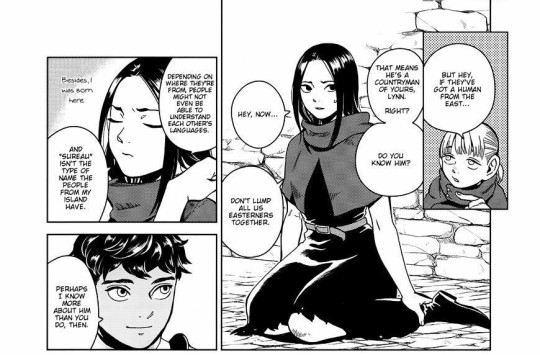
In her Adventurer's Bible entry, she's described as having "no real knowledge or attachment to the East" because "she's second-generation." She also clarifies to Mickbell that she was "born here." From this character description and her dialogue, we get the sense that Rin doesn't really identify with being Asian.

As noted in this Rin masterpost, a large part of this is because she was denied her parents' cultural identity by the elves. They likely suppressed any cultural markers she had and denied her information about her heritage. Since she wasn't born in the Eastern Archipelago and her parents died when she was young, she understandably hasn't inherited a lot of cultural knowledge.
Rin seems to have internalized ethnic self-hatred. Her disconnect from the East and her unwillingness to remedy that disconnect suggests that she has shame surrounding her Asian identity.
Again, she doesn't have many opportunities to interact with people from her parents' homeland, and her trauma also impacts her behavior. Remembering her parents is probably painful, considering the horrible way they died, and since they're her main connection to her cultural heritage, it makes sense that she wouldn't broach the topic.
You could also argue that Rin identifies more with her Northern identity than her Eastern identity since she was born and raised in the North for the first eleven years of her life, and as a result, she doesn't feel the need to connect with her parents' culture. But considering her home was presumptively still steeped in her parents' culture and her main association with the North is probably her parents' murders, this seems unlikely.
It's important to note how different her experiences are from the story's other Asian characters', like Toshiro's, for example. Toshiro travels to the Island as an adult of his own volition (technically, his father's). He's completely culturally Eastern. In comparison, Rin's parents fled from the East. Her family had to assimilate into an unfamiliar Northern culture, and later, she was "raised" by western elves, who are coded as colonizers in text. She seems to have internalized the elves' suppression of her culture and the way assimilating to the North required them to discard parts of their heritage. Her lack of interest in her culture seems learned.
Her strong attachment to Kabru further complicates her relationship with her Asian identity. I see Kabru as Indian or Nepalese; his name derives from a mountain on the border between India and Nepal. On top of being the only person who treats her like a human being during her childhood, Kabru is the only other significant Asian person in her life. They share the trauma of their parents having been brutally murdered and being raised imperfectly (much more severely in her case) by elves. While in the elf's care, they're both othered as tallmen— this aspect is strongly emphasized in the text — and in the main story, they're othered as Asian people in its European-inspired setting. Their shared experiences as Asian refugees are the foundation of their close bond.
It's not a stretch to assume that Rin consequently views Kabru as her main connection to being Asian. While they're from very different parts of fantasy Asia, their experiences as Asian refugees still overlap significantly as seen above, and the way she clings to Kabru suggests she wants to connect more with her culture, but for the previously stated reasons, she doesn't prioritize it. Besides, she doesn't have good models for what embracing one's cultural identity as a refugee/immigrant looks like. Just like her, Kabru doesn't seem to have many cultural ties, similarly because of his upbringing with the elves.
Toshiro could completely topple Rin and Kabru's original dynamic. Rin doesn't seem to like Toshiro. Their personalities would probably clash at first, because just like him, she's prone to judgment, out of self-preservation, and she's quiet. One of their canonical interactions is being captured by the orcs together; they don't even speak to each other in this scene.

Kabru and Toshiro become friends by the story's conclusion. Deep down, Rin might feel threatened by this. She's been Kabru's closest Asian friend up until this point. Toshiro, as an Asian person who was born and raised in his culture, might seem like a "better Asian" and thus, Kabru's replacement for her. This would be the worst projection of her buried insecurity over her disconnect from being Asian and how it potentially separates her from other Asian people. Given her personality, I doubt she would express this beyond acting wary around Toshiro.

With time, Rin, Kabru, and Toshiro could resolve her fears and the deeper issues they point to by all becoming friends. Interacting with other Asian people would heal her. She appears unphased by Mickbell's microaggression, implying it isn't an uncommon occurrence; she seems to only hang out with Kabru and their party. Being around other people of color would lessen the amount of othering she experiences and grant her a break from defending her identity.
Beyond the potential for cultural exchange and bonding over being Asian in fantasy Europe, Rin and Toshiro are also very similar in character. They're both anxious, quiet, and caring. If they made a little effort, they'd relate to each other and get along well.
Ideally, Rin would also befriend Hien, Benichidori, and the other girls in Toshiro's party. Kabru and Toshiro have their own issues with their treatment of women, so without positive Asian female friendships, she'd have another issue on her hands. Still, Kabru could be the bridge to a friendship with Toshiro, and Toshiro could be the bridge to friendships with his retainers. And with mutual growth, they could all enjoy each other's friendships.
Rin herself points out the vast cultural differences and language barriers between different parts of the East. The Asian characters of DunMeshi might not always share culture, but because of the story's setting in fantasy Europe, many of them experience being nonwhite in a mostly white locale. A support system of other people of color could allow Rin the space to explore her identity and culture and begin healing from her childhood trauma.
#rinsha fana#rin dungeon meshi#dungeon meshi#dunmeshi meta#kabru#toshiro nakamoto#shuro#kabru of utaya#my silly thoughts abt rin but also just me heavily projecting other asian am ppl in my life onto dunmeshi charas#love rin dearly#it's so important to me that all the asian charas become friends and bond over being asian#dunmeshi#delicious in dungeon#*mine#*meta
146 notes
·
View notes
Text
Rules/Recommendations for writing an Australian character/OC
(The following is just a list of things I personally feel should be included or considered if one makes a character of Australian nationality, descent or heritage. It by no means is a hard and fast ruleset, but just things that can be done to enhance a character’s flavour or add a little authenticity)
Shortened nicknames for fellow characters that follow Australian Shortening Conventions: multi-syllablic names are condensed down to one, and an -a/ah, -o, -zza, -y, or -sy is added, eg: McKenzie (or and Mc name) > Macca, Damien > Damo (Day-mo), Jeremy > Jezza.
Swearing. This is actually a common trap I’ve seen, with some Australian characters being less reserved in their language than others. This will depend on the specific background of your Aussie, as vulgarity is moreso a commonality in smaller cities and rural spaces, and less so in larger built-up cities. That said, we do tend to through the more vulgar words around with greater frequency than other cultures, with f### and c### being thrown around more freely.
Slang. Again another trap, especially with older “stereotypical” Australian slang that I personally hear more from my grandparents and older uncles and aunts and less so my own peers + 10 years. That said, some terms are still used very frequently and have no generational boundaries, including but not limited to: ute (pickup truck), bottle-o (liquor store), servo-o (service/petrol station), “the shops” (any centralised marketplace from your general stores to large malls), booze bus (roadside randomised breath testing/DUI checkpoints, some which do both alcohol and drug testing), hoon (reckless driver, typically young males in cars too powerful to handle at their skill level).
Weather tolerances. This varies based on a character’s geographical background, but you’ll find that most Australians have higher than normal levels of tolerance to extreme heat. However, those that live around the Brisbane latitude and north have decreased tolerances to cooler temperatures, decreasing the further north you go. (Personally I find myself pulling on long sleeves and hoodies after it hits 20 or cooler.)
There’s probably more here, but it’s approaching 10pm for me at time of writing, so for my Aussie followers/mutuals, please feel free to expand upon or add your own tips or recommendations to writing Australian characters in a believable fashion. Curious to see what they are!
#ramblings#australia#australian characters#definitely not trying to project my own personal feelings onto others#but the number of stereotypes i read in fiction and fan fiction is starting to aggravate me#like some of y’all have never actually spoke to an Australian person and it shows#even if i am guilty of employing some of these tropes and stereotypes to an extent in my own writing
156 notes
·
View notes
Text
(1st meeting) 2023/3rd Session of the United Nations Group of Experts on Geographical Names.
Theme: "Strengthening relationships, links and connections in geographical names standardization and for sustainable development and pandemic recovery". The 2023/third session of the United Nations Group of Experts on Geographical Names (UNGEGN) will be convened from 1 to 5 May 2023 at the United Nations Headquarters in New York.
The following are some major topics to be addressed during the session: - place names supporting sustainable development, toponymic data management and gazetteers, romanization systems, diversity and inclusion, capacity building in toponymy and geographical names as cultural heritage.
UNGEGN sessions provide a forum where experts from the interrelated fields of geography, cartography, geospatial information, linguistics and history, from across the world come together to learn and share best practices and norms, new developments in geographical names administration and standardization. The session also highlights the Group's role as an enabler in preserving cultural heritage and where appropriate support relevant aspects of the 2030 Agenda for Sustainable Development.
This session will address the theme "Strengthening relationships, links and connections in geographical names standardization and for sustainable development and pandemic recovery". This theme is not only aligned to the theme of the 2023 ECOSOC High-level Political Forum on sustainable development, but also to UNGEGN's Strategic Plan and Programme of Work 2021-2029, Strategy 2: Relationships, links and connections.
Good relationships, links and connections are fundamental to all UNGEGN's strategies and are at the heart of the work of the United Nations. Therefore, it is beneficial to encourage focus on this topic and create a platform through the 2023 session to explore the various types of relationships (formal/informal, organizational/individual) employed by Member States to achieve their goals, and in turn support UNGEGNs vision.
#cultural heritage#plenary meetings#UNGEGN#sustainable development#toponymic data management#gazetteers#romanization systems#diversity and inclusion#capacity building#geographical names#toponymy
0 notes